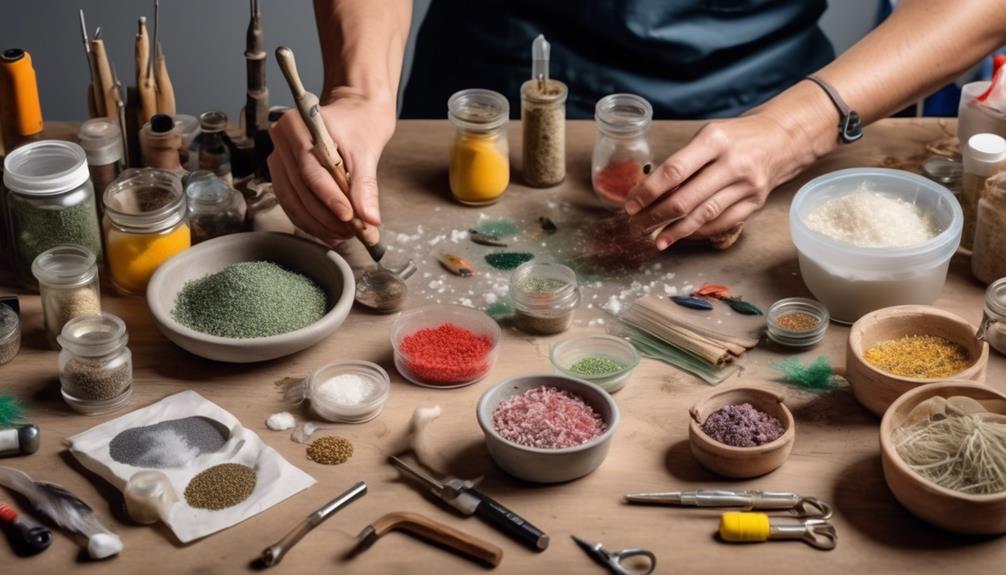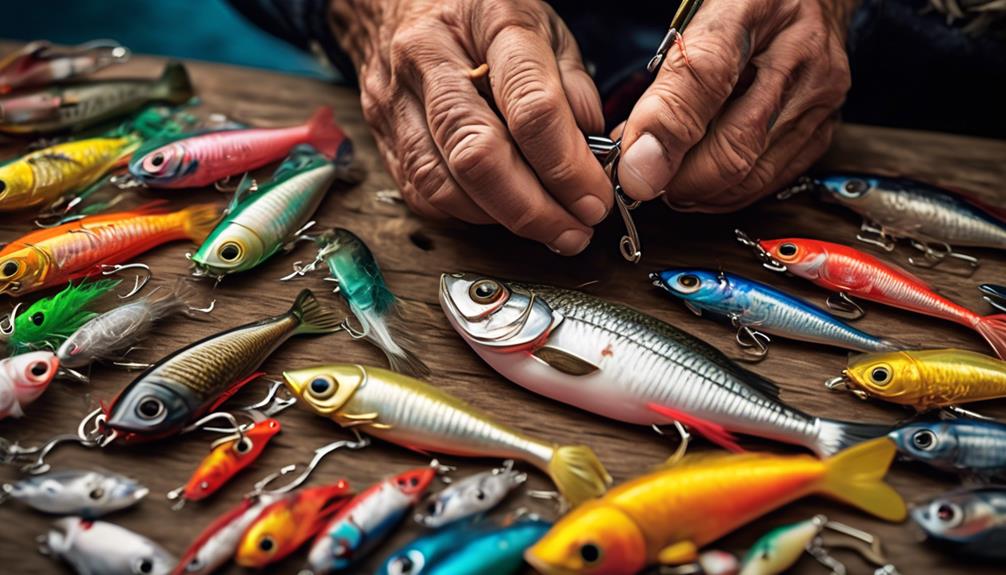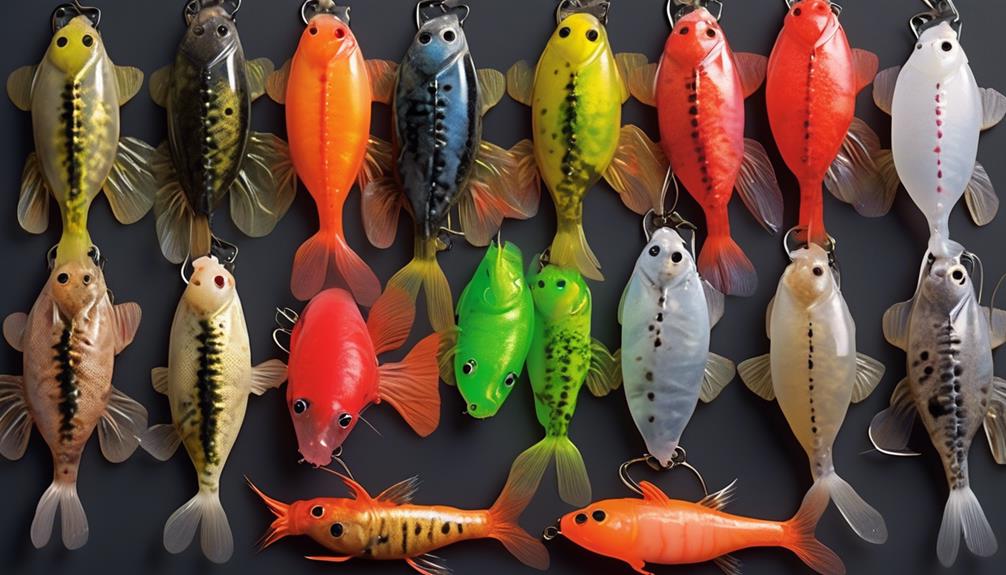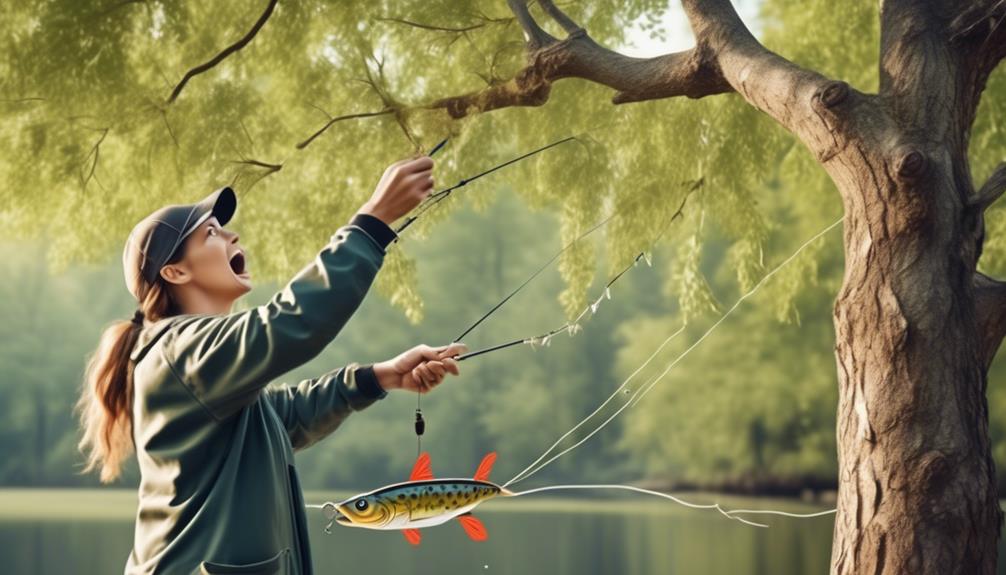Ever heard the saying, 'Give a man a fish, and you feed him for a day; teach a man to fish, and you feed him for a lifetime'?
Well, the same principle applies to making your own fishing baits.
By taking the time to DIY your fishing baits, you not only gain a deeper understanding of the art of angling, but you also have the opportunity to create custom baits tailored to the specific fish you're targeting.
The benefits go beyond just the satisfaction of crafting your own lures.
You'll find that there's a whole world of creativity, cost-effectiveness, and success waiting for you in the realm of DIY fishing baits.
Benefits of DIY Fishing Baits
Creating your own fishing baits can lead to cost savings and a sense of satisfaction in customizing your fishing experience. By making your own baits, you can save a significant amount of money compared to purchasing them from stores. With a little creativity, you can design baits that aren't only effective but also cost-effective.
By using materials that are readily available, you can create a wide variety of baits at a fraction of the cost of buying them pre-made. This cost-effective approach allows you to experiment with different designs and styles without breaking the bank.
In addition to being cost-effective, making your own fishing baits allows you to explore and create unique and creative designs. You have the freedom to customize the shape, size, color, and scent of the baits to suit the specific fish species you're targeting. This level of customization can give you an edge over commercially available baits, as you can tailor your creations to mimic the natural prey of the fish in your area.
Furthermore, the process of designing and making your baits can be a fulfilling and enjoyable experience. It allows you to tap into your creativity and apply your own personal touch to the baits, making each fishing trip more rewarding.
Essential Tools for Making Baits
To craft your own fishing baits effectively, you'll need a few essential tools that are crucial for the bait-making process. These tools will help you customize your baits to suit your fishing needs and ensure the safety and effectiveness of your DIY bait.
- DIY Bait Molds: Investing in DIY bait molds allows you to create baits in various shapes and sizes, giving you the flexibility to tailor your baits to specific fishing conditions and target species.
- Bait Making Equipment: Essential equipment such as a microwave or a hot plate for melting plastic, a mold release agent, and a heat source for curing resin are fundamental for creating custom baits. These tools are vital for effectively crafting your baits with precision and care.
- Bait Crafting Techniques: Knowledge of various bait crafting techniques such as injection molding, hand pouring, and resin casting is crucial for creating baits that mimic natural movements and appearances. Mastering these techniques will enable you to produce high-quality baits that attract fish effectively.
- Bait Storage Solutions: Proper storage solutions such as tackle boxes with adjustable compartments and airtight containers for preserving homemade baits are essential for maintaining the freshness and effectiveness of your baits. This ensures that your DIY baits remain in top condition for your fishing trips.
Choosing the Right Ingredients
When making your own fishing baits, selecting the right ingredients is essential for creating effective and enticing lures. Ingredient selection plays a crucial role in customizing your bait recipes to suit the specific fishing conditions and target species. One of the main advantages of DIY bait is the ability to tailor your ingredients to match the natural prey of the fish you're targeting. This customization can significantly increase your chances of fishing success.
The first step in choosing the right ingredients for your fishing baits is to consider the type of fish you want to catch. Different species have different preferences for taste, texture, and scent, so understanding the feeding habits of your target fish is key. For example, if you're targeting catfish, ingredients like chicken livers or garlic may be effective, while bass may be more enticed by crayfish or shad.
Next, take into account the fishing conditions such as water clarity, temperature, and time of year. For muddy water, using ingredients with strong scents and flavors can help attract fish, while in clear water, natural colors and more subtle scents may be more effective.
Step-by-Step Guide to Making Lures
Considering the ingredients selected for your fishing baits, you can now proceed to crafting your lures with a step-by-step guide.
- Design Your Lure: Start by sketching a design for your lure on a piece of paper. This will help you visualize the shape and size of the lure before you start crafting it.
- Create the Body: Use wood, cork, or foam to create the body of your lure. Carve or shape it according to your design using carving tools or sandpaper. Ensure it has a smooth and streamlined shape to attract fish.
- Lure Painting: Once the body is crafted, it's time to add color. Choose vibrant and eye-catching paint to attract fish. Use small brushes to carefully paint the lure, and let it dry completely before adding a clear coat for protection.
- Homemade Spinners: To add movement and attract more fish, consider adding homemade spinners to your lure. Use small metal pieces and beads to create spinners that will rotate in the water, mimicking the movement of prey.
Customizing Baits for Different Fish
Customize your baits for different fish by adjusting the size, color, and movement to match the preferences of the specific species you're targeting. Bait customization is essential because different fish species have unique feeding habits and behaviors. Understanding fish behavior is crucial when creating DIY baits.
For example, predatory fish like bass are attracted to larger, more vibrant baits that mimic the movement of injured prey. In contrast, panfish such as crappie and bluegill are often enticed by smaller, subtler baits that resemble insects or small baitfish. By customizing your baits to suit the specific fish species you're targeting, you can significantly increase your chances of a successful catch.
Additionally, bait customization can have positive environmental impacts. By using baits that are specifically designed for the target species, you can reduce the likelihood of accidental bycatch, where non-targeted or protected species are caught. This can help in the conservation of vulnerable fish populations and contribute to sustainable fishing practices.
Furthermore, understanding the behavior of different fish species allows you to create baits that are more effective, reducing the amount of time and resources spent on unsuccessful fishing trips. By tailoring your baits to the preferences of the fish you're targeting, you can optimize your fishing experience and potentially reduce the overall impact on fish populations.
Tips for Storing Homemade Baits
To ensure your customized baits remain effective for future fishing trips, it's important to properly store them to maintain their quality and appeal to the targeted fish species. Here are some essential tips for storing homemade baits:
- Proper Preservation for Long Term Use:
After creating your homemade baits, it's crucial to store them in airtight containers to prevent exposure to air and moisture, which can lead to spoilage. Consider using vacuum-sealed bags or airtight plastic containers to maintain the freshness and effectiveness of your baits over an extended period. Additionally, you can add silica gel packets to absorb any excess moisture and preserve the integrity of the baits.
- Moisture Control:
Moisture can significantly impact the quality of your homemade baits. To mitigate this, ensure that the containers used for storing the baits are completely dry before placing the baits inside. Furthermore, storing the baits in a cool, dry place can help prevent moisture buildup, which can lead to mold and spoilage.
- Avoid Exposure to Sunlight:
Ultraviolet (UV) rays from sunlight can degrade the quality of your baits over time. It's important to store your homemade baits in a dark or opaque container to shield them from direct sunlight exposure. This will help maintain the color, texture, and effectiveness of the baits.
- Labeling and Organization:
Properly labeling your containers with the type of bait, date of creation, and any additional relevant information can help you keep track of the baits' freshness and effectiveness. Additionally, organizing your storage space can prevent any accidental damage or mixing of different bait types, ensuring that each bait remains distinct and effective for its intended purpose.
Testing and Improving Your Baits
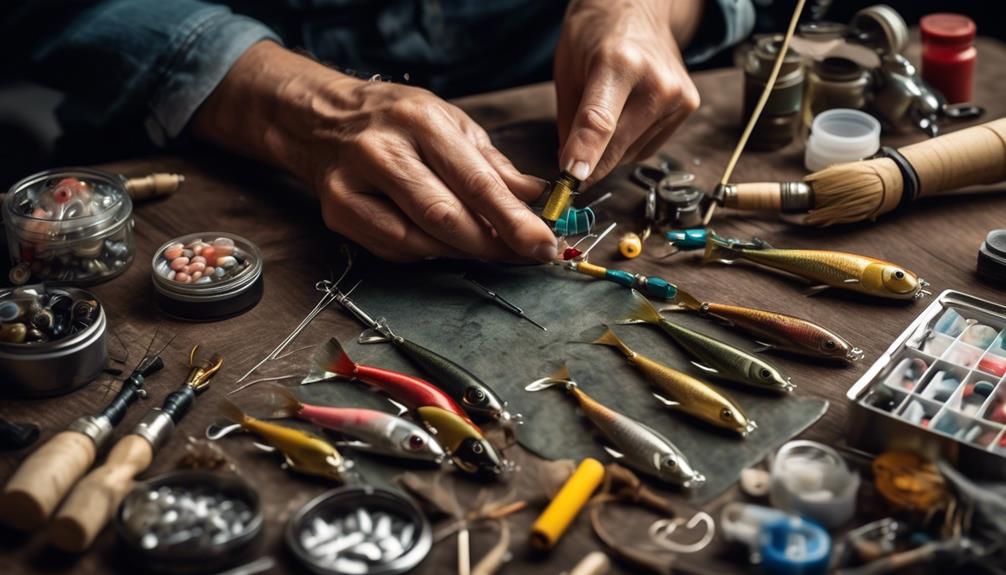
When evaluating the effectiveness of your homemade baits, conduct thorough testing to assess their appeal and performance in attracting the targeted fish species. Start by considering bait formulation. Experiment with different ingredients and ratios to find the most effective combination for your target fish. You can then make bait modifications based on your initial formulation and the results of your field testing.
Field testing is crucial for gauging how well your baits perform in real fishing conditions. Take note of the specific fish species you're targeting, the water conditions, and the time of day when testing your baits. This will help you understand the optimal scenarios for using your homemade baits. Additionally, observe the behavior of the fish towards your baits. Are they showing interest and actively pursuing the bait, or are they indifferent? Such insights will guide you in making necessary bait modifications to enhance the appeal and effectiveness of your baits.
After conducting field tests and making bait modifications, it's essential to continue with performance evaluation. Keep detailed records of your fishing trips, noting which baits yielded the best results and under what conditions. This ongoing assessment will allow you to refine your bait formulations and modifications, ensuring that your homemade baits consistently deliver successful fishing experiences.
Safety Precautions When DIYing Baits
For safe DIY bait making, remember to carefully handle all ingredients and tools to prevent accidental exposure or injury. When making your own fishing baits, it's important to prioritize safety measures to ensure a smooth and secure bait-making process. Here are some essential safety precautions to keep in mind:
- Use Personal Protective Equipment (PPE): Prioritize safety by wearing gloves, goggles, and a mask to protect yourself from potential hazards such as toxic fumes or skin irritation from certain bait-making ingredients.
- Proper Ventilation: Ensure that your workspace is well-ventilated to prevent the inhalation of harmful fumes. Consider setting up near an open window or using a fan to help disperse any lingering odors or vapors.
- Handle Chemicals Carefully: When working with chemicals or potentially harmful substances, be sure to read and follow all safety instructions provided with the products. Store these items in a secure location away from children and pets.
- Clean Up Thoroughly: After you've finished making your baits, carefully clean all tools and equipment to prevent cross-contamination or accidental exposure. Dispose of any waste materials properly, following local regulations for hazardous waste disposal.
Frequently Asked Questions
Are There Any Specific Regulations or Restrictions on Using Homemade Baits in Certain Fishing Locations?
When it comes to using homemade baits for fishing, it's important to be aware of the regulations and location restrictions.
Some fishing locations may have specific rules regarding the use of DIY fishing baits. It's crucial to check with the local authorities or fishing regulations to ensure that you're compliant with any restrictions on using homemade baits in those areas.
Always stay informed and follow the guidelines to avoid any issues.
Can Homemade Baits Be as Effective as Store-Bought Baits in Attracting Fish?
Homemade baits can be just as effective as store-bought ones in attracting fish. In fact, many anglers find that DIY baits work even better.
They allow you to customize your baits to suit the specific fish you're targeting and the conditions you're fishing in.
Plus, making your own baits can save you a lot of money in the long run. It's a cost-effective and rewarding way to improve your fishing experience.
What Are Some Common Mistakes to Avoid When Making Homemade Baits?
When making homemade baits, common mistakes to avoid include:
- Using improper ingredients: Using expired or low-quality ingredients can deter fish.
- Neglecting quality control: Inadequate quality control might result in inconsistent bait performance.
- Not following proper storage methods: Improper storage methods can lead to spoilage and reduced effectiveness.
How Long Can Homemade Baits Typically Last Before They Need to Be Replaced?
Homemade baits can last a long time if stored properly. Some storage tips include keeping them in airtight containers to maintain freshness and prevent spoilage.
The shelf life of homemade baits depends on the preservation methods used. DIY baits can be just as effective as store-bought ones and have the added benefit of being sustainable with a reduced environmental impact.
Always be aware of any regulations regarding homemade baits to ensure responsible and legal use.
Are There Any Environmental Concerns or Considerations When Using Homemade Baits?
When using homemade baits, it's essential to consider the environmental impact and sustainability.
Ensure your DIY baits comply with fishing regulations and don't harm the ecosystem.
Assess the effectiveness of your homemade baits in attracting fish while minimizing any potential negative effects on the environment.
It's crucial to prioritize sustainable practices and minimize any adverse impact on the ecosystem when using DIY fishing baits.
Conclusion
So, why should you DIY your fishing baits?
It's simple – you have the freedom to customize, experiment, and save money.
With the right tools and ingredients, you can create baits tailored to specific fish and fishing conditions.
Plus, making your own baits can be a fun and rewarding experience.
Just remember to prioritize safety, test your baits, and don't be afraid to tweak and improve them until you find the perfect formula for a successful fishing trip.
